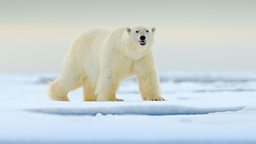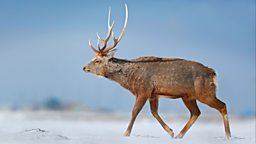Main content
Stunning survivors: the secret skills of snow animals
Liz Bonnin introduces a cast of charismatic animals in Snow Animals on Monday 30th December, 7pm, �鶹������ҳ��� One. Meet some of the stars below and find out just how they make it through the winter chill.
Snow leopard

The Himalayas are home to one of the planet’s most elusive creatures: the snow leopard. Living in the world’s highest mountains, this big cat’s home range can be as large as 1000 square kilometres. It can take a snow leopard over a week to cover his entire territory - walking hundreds of miles in search of a mate, even in the deepest snow. Scientists estimate there may be as few as 4,000 left in the wild, so every new litter born is vitally important.
Snowshoe hare

The aptly named snowshoe hare has especially large, furry paws which stop it from sinking into the snow - they are fast and nimble, and can leap 3 metres in a single bound. Its fur perfectly matches its snowy, white world – but it doesn’t look like this all year round. Throughout the spring and summer months, its fur is reddish-brown, to match its habitat at this time of year. But as winter approaches, and the snow starts to fall, it transforms from brown to purest white. Snowshoe hares have many predators, from coyotes to golden eagles, and lynx, so this winter white coat is an excellent camouflage.
Polar bear

The polar bear is the largest living bear on the planet. In their Arctic home, they face some of the harshest conditions on earth, with temperatures of minus 50C. Polar bears keep warm due to a combination of thick fur, and a layer of blubber that can be up to 10cm thick. They spend most of their life travelling thousands of kilometres over the ice as they search for mates, and hunt seals. Female polar bears are dedicated and protective mothers – they keep their cubs close, and call to them when they wander too far.
Bobcat

The bobcat is a species of Lynx, found in North America. About twice the size of a domestic cat, they are elusive and mostly nocturnal, so are rarely seen by humans. Bobcats roam across a range of habitats from forests and swamps, to deserts and even suburban areas. They have evolved excellent hearing, with ears that can swivel back and forth independently of one another, and their characteristic ear tufts are thought to help amplify sound, or are used like whiskers to detect things above their head. Their preferred prey is rabbits and hares but they will also hunt insects, birds, small rodents and deer.
Arctic fox

The Arctic Fox is native to the Arctic regions of the Northern Hemisphere. It is well adapted to living in cold environments, and can cope with sub-zero winter temperatures thanks to its thick, warm fur. Arctic foxes have white coats that act as very effective winter camouflage, allowing it to blend into the snow and ice. When the seasons change, the fox's coat becomes brown or gray, providing cover among the summer tundra's rocks and plants. It’s an accomplished hunter, feeding mostly on lemmings and voles.
Sika deer

Also known as the spotted deer or the Japanese deer, the Sika deer is native to much of East Asia, but was introduced to other parts of the world over the last century, and has now established itself in many countries including the UK, Canada, the US, and parts of Europe. The sika deer is a very adaptable animal. In winter, like most deer species, it grows a thicker coat, with two layers - a top coat of long, weatherproof hair and a dense, soft undercoat. Even when the snow is several feet deep, sika deer can dig through it for their favourite foods such as bamboos and other grasses. And when winters get really tough, these deer are able to adapt to another food source that can be found more easily – tree bark. They can gain nutrition from bark because of the way their digestive system has evolved.

Liz Bonnin: “Winter can be a spectacular season, but for the wildlife that must survive it, it can be the most demanding time of all. I’ve always been fascinated by the remarkable strategies animals have evolved to overcome life's challenges - nature is astoundingly resilient and resourceful! Snow Animals celebrates the many ways in which they can adapt to even the harshest winters, while unravelling the science behind their fascinating behaviours."
Snow Animals is on Monday 30th December, 7pm, �鶹������ҳ��� One
